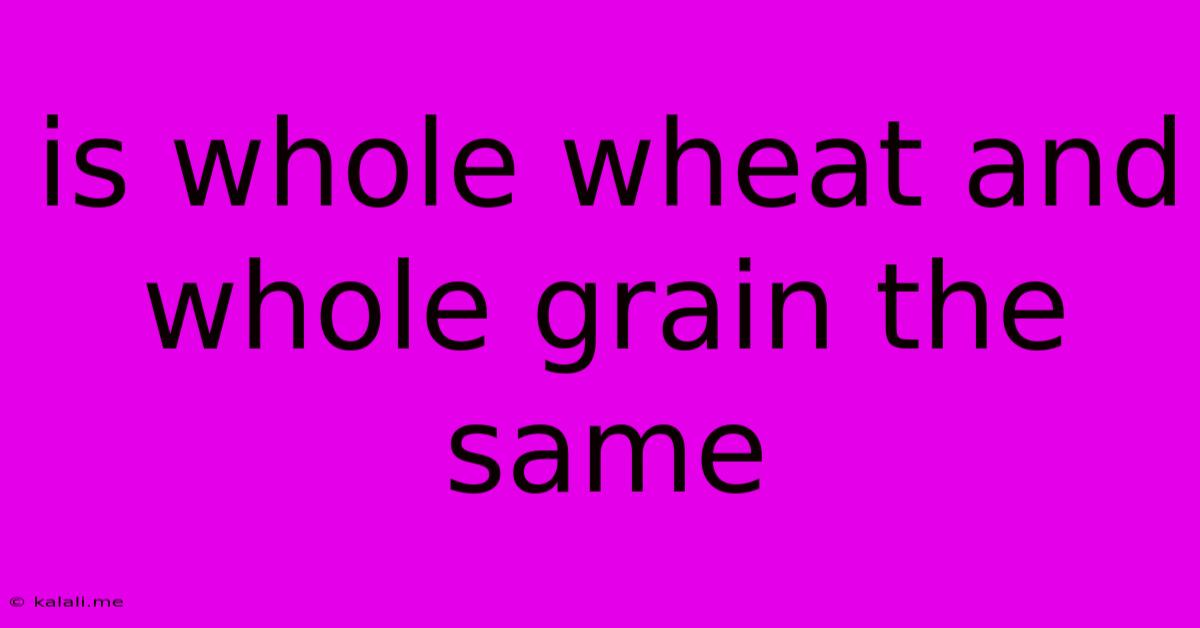Is Whole Wheat And Whole Grain The Same
Kalali
May 26, 2025 · 3 min read

Table of Contents
Is Whole Wheat and Whole Grain the Same? Unpacking the Nutritional Differences
Are whole wheat and whole grain the same thing? While often used interchangeably, there's a subtle but important distinction. This article will delve into the specifics, clarifying the relationship between whole wheat and whole grains, and highlighting their individual nutritional benefits. Understanding this difference can empower you to make more informed choices about your diet and overall health.
Whole wheat and whole grains are frequently confused, leading many to believe they are synonymous. However, whole wheat is a type of whole grain, not the other way around. This means that all whole wheat is a whole grain, but not all whole grains are whole wheat. Let's break down this key distinction.
What are Whole Grains?
Whole grains encompass a broad category of grains that retain all three parts of the kernel: the bran, the germ, and the endosperm. These components contribute different nutrients:
- Bran: The outer layer, rich in fiber, B vitamins, and minerals.
- Germ: The embryo of the grain, packed with vitamins, minerals, and healthy fats.
- Endosperm: The largest part, mainly providing carbohydrates.
Examples of whole grains include brown rice, quinoa, oats, barley, and, of course, whole wheat. The presence of all three kernel components makes whole grains nutritionally superior to refined grains, which have had the bran and germ removed. This refining process removes much of the fiber, vitamins, and minerals, leaving primarily carbohydrates.
Understanding Whole Wheat
Whole wheat flour is made from grinding the entire wheat kernel—bran, germ, and endosperm—into flour. This means whole wheat flour retains the nutritional benefits of all three parts of the wheat kernel. It's a popular choice for bread, pasta, and other baked goods. Its higher fiber content contributes to digestive health, and its sustained energy release helps prevent blood sugar spikes. Look for products clearly labeled "100% whole wheat" to ensure you're getting the full nutritional package.
Key Differences Summarized
| Feature | Whole Wheat | Whole Grains |
|---|---|---|
| Definition | A specific type of grain | A broad category encompassing many grains |
| Components | Entire wheat kernel (bran, germ, endosperm) | Entire kernel of various grains (bran, germ, endosperm) |
| Examples | Whole wheat bread, pasta, flour | Brown rice, quinoa, oats, barley, whole wheat |
| Nutrient Profile | High in fiber, B vitamins, minerals | Varies depending on the specific grain, generally high in fiber and micronutrients |
Choosing Whole Grains for a Healthier Diet
Including both whole wheat and other whole grains in your diet offers a range of health benefits. These include improved digestion, better blood sugar control, reduced risk of heart disease, and increased satiety, which can aid in weight management. Prioritizing whole grains over refined grains is a significant step towards a healthier lifestyle. Read food labels carefully to identify whole grains and whole wheat products, paying attention to ingredient lists and nutritional information. Remember, even small swaps can make a big difference in your overall health and wellbeing.
Latest Posts
Latest Posts
-
How Long Does Clamato Juice Last
May 27, 2025
-
Is Delta H Products Minus Reactants
May 27, 2025
-
How To Find Bases For Eigenspaces
May 27, 2025
-
Do You Put A Book Title In Quotations
May 27, 2025
-
Are The Jews Still Gods Chosen People Christianity
May 27, 2025
Related Post
Thank you for visiting our website which covers about Is Whole Wheat And Whole Grain The Same . We hope the information provided has been useful to you. Feel free to contact us if you have any questions or need further assistance. See you next time and don't miss to bookmark.